Chinese Name: 朗德苗寨 Pronunciation: lǎng dé miáo zhài
Opening Hours: 24 Hours
Ticket: Free for entry
Best Visiting Time: August
Building Function: Residential district
Recommended Time for Visit: 2-3 Hours
Address: Langde Town, Leishan County, Qiandongnan Miao and Dong Autonomous Prefecture, Guizhou Province
Popular Activities: Live in the Miao Village, experience the life of the locals, taste farm dishes, celebrate special festivals with the Miao people, and feel the Miao customs.
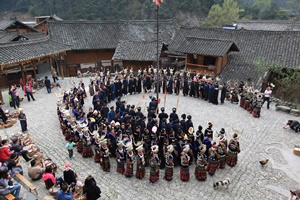
Langde Miao Village belongs to Langde Town, Leishan County, Qiandongnan Miao and Dong Autonomous Prefecture, Guizhou Province. It is 27 kilometers away from Kaili City and 17 kilometers away from Leishan County Government. It is one of the key villages for ethnic customs tours in Guizhou Province. There are two natural villages in Langde, the upper and lower natural villages. The one that is open to public is the upper one, so the more formal name should be "Langde Shang Miao Village"(Shang means upper in Chinese).
The costumes of the Miao people in this village Langde are characterized by long skirts, so the village is also called "Long Skirt Miao". Langde Shang Miao Village is a free translation of "Neng Dui Ang Jiu" in the Miao language. "Neng Dui" means the lower reaches of the Oudui River and "Ang Jiu" means “shang village”. The village is named after the river because it belongs to the upper part of the Langde area.
As the China's first folk-custom village tour destination, it is famous for Diaojiaolou (a wooden house high above ground), Lushengtang (a dance), Fengyuqiao (a bridge), etc. During the festival or when the tour group arrives, there will be a warm welcome ceremony and grand Miao song and dance performances such as Lusheng Dance, Bronze-drum Dance, and Bench Dance. Later "ethnic minority’s villages" that emerged throughout the country were all inspired by Langde Miao Village.
Langde town is endowed with unique national tourism resources. It is renowned as the "Hometown of Chinese Folk Songs and Dances", "National Hundred Open-Air Museums" and "Hometown of Lusheng". The ancient buildings of Langde Shang Miao Village are listed as the fifth batch of Key Cultural Relics Protection Units in China.

Langde Shang Miao Village is open to public. There are more than 100 households with more than 500 people, all of whom are Miao people. This is the hometown of Yang Daliu, the Miao uprising general during the Xianfeng and Tongzhi reigns of the Qing Dynasty. The walls, trenches and gates and other remains built in those years still exist.
The village is backed by mountains and water, with towering ancient trees. Visitors will be warmly welcomed by the local people, and the reception way is very special. The Miao people in the village dressed in festive costumes, sang moving toast songs, presented twelve courses of way-blocking wines to the guests, and welcomed them in a special way of "blocking" guests from entering the village. When tourists enter the gate, they will dance on Tonggu Ping with the Miao people. Accompanied by the sound of bronze drums and Lusheng, tourists who come here for sightseeing often can't help but dance with them.
After the big welcoming ceremony, travelers can visit the village at will. Scenic spots such as Diaojiaolou, Fengyuqiao, Lushengtang and performances by villagers are all worth seeing. For the convenience of tourists to visit village, there is also a unique exhibition room for ethnic and folk cultural relics.

From 1855 to 1872, the Hmong rebelled against the Qing Dynasty. It took the Qing army 18 years to put down the Langde Miao Village because it was the stronghold of the rebel general Yang Daliu.
In 1985, as a tourist spot of ethnic customs in Southeastern Guizhou, Langde Shang Miao Village took the lead in opening to public.
In 1993, it was recorded in The Annals of China Museum;
In 1997, it was named " Hometown of Chinese Folk Art " by Ministry of Culture.
In 2001, it was listed as Key National Relics Protection Units and has also became the first choice for tourists to explore Miao culture and appreciate Miao customs.
During the 2008 Olympics, Langde Miao Village became the only Miao Village in the country where the torch passed.
Many Communist Party and state leaders and VIPs from dozens of countries have visited Langde Shang Miao Village. It receives more than 30,000 Chinese and foreign tourists every year and has become a tourist hot spot on the eastern travel route of Guizhou.
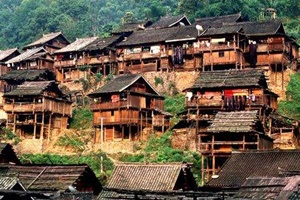
Most of the Miao people live in mountainous areas with high mountains and steep slopes. It is extremely difficult to level and excavate the foundation. In addition, the weather is changeable, humid and foggy, and the bottom of the brick house is very humid, making it unsuitable for living. Therefore, the Miao people have always built a kind of dry wooden building with good ventilation performance, called "Diaojiaolou".
Diaojiaolou buildings in Langde Miao Village are generally of wooden structure, which looks charming. Most of them have a typical three-layer structure: the first floor is for pigs and cattle, the second floor is for people, and the third floor is for food and sundries.
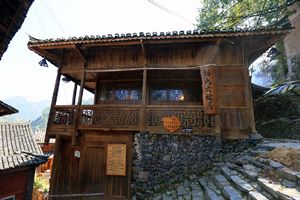
Among Langde's hundreds of wooden buildings, there is one common wooden building worth mentioning, because it tells people a little-known heroic history. This is the Former Residence of Yang Daliu.
Yang Daliu was the chief general of the Zhang Xiumei uprising, the largest Miao uprising in the history of China's Miao nationality. In the fifth year of Xianfeng (1855) of the Qing Dynasty, the Miao people in southeastern Guizhou could not bear the cruel exploitation and oppression, setting off an uprising that lasted 18 years. Yang Daliu responded positively and made many remarkable achievements. In the eleventh year of Tongzhi (1872), Yang Daliu was captured together with Zhang Xiumei in Wudongpo of Leigong Mountain. At that time, the imperial court wanted to grant them high officials but they refused. Finally, Yang Daliu died after being tortured in Changsha, Hunan Province. His deeds are widely spread, and The Song of Yang Daliu is still popular in the local area.
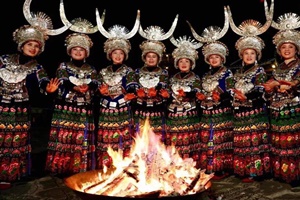
"Campfire Party" began from August 17, 2020. It is performed at 20:00-21:00 in the Langde Miao Village Sanchakou Campfire Party Square. At the Campfire Party, the flame is flourishing, reflecting the Miao sisters' costumes and smiles. The majestic Lusheng Dance, accompanied by bursts of Miao songs, captivated tourists from all over the world. The visitors held hands with the Miao people, singing and dancing around the campfire to the rhythm of ancient music, and all were immersed in the beauty of the party.

When the distinguished tourists enter Langde Miao Village, they have to follow the customs of the Miao people—drinking way-blocking wine. Starting from the road at the foot of the village to the gate of the village, many roadblocks of wine to welcome guests are set up, as many as 12. At each wine block, there is a square table in the middle of the road, and a few young men and women of the Miao nationality in traditional Miao costumes stand by both sides. They are ready to toast the guests with wine bowls in their hands. Two earthen bowls filled with wine to express happiness and longevity are offered at a time. The last wine block is at the gate of the village, and the people in the local village replace the earthen bowl with a big ox horn. In this way, if a tourist wants to drink all the wine on the way, he or she must be good at drinking. However, guests who are not good at drinking do not have to worry. As long as you hold your hands behind your back, bend over and touch the wine bowl with your lips, then separate immediately, and politely say "Doushemo" ("Thank you" in Miao language), and then you can enter the gate of the village. Although the host is hospitable, he or she will never insist on others doing anything impossible or against his will.
Visitors are welcomed by the ceremony of saluting gun, setting off firecrackers, playing the mangtong (a reed-pipe wind instrument) and singing toasting songs. After that, all the villagers come out to welcome the visitors, leading them to the Lu Qian Field in the center of the village. The women wear embroidered skirts and silver coronets on their heads while the men wear gowns and mandarin jackets. With a bronze drum hanging high above the field, young villagers here present traditional Miao songs and dances to the guests: Lusheng Dance, Bench Dance, Wooden Drum Dance, Bronze Drum Dance and so on. Finally, the whole village, men and women, young and old, get together, forming several concentric circles. With the percussion of bronze drums, they dance slowly and invite tourists to join them, bringing the carnival to a climax. After singing and dancing, visitors can walk into the ordinary Miao family at will. Enthusiastic villagers will invite you to come again for First Harvest of the Year or the New Year of the Miao, which are their most solemn festival.
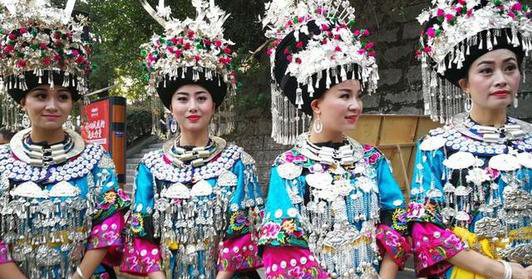
The costumes of the Miao nationality, called “Ouqian” in Miao language, are mainly composed of children’s clothes, casual clothes, and splendid attires. Silver ornaments, Miao embroidery, and batik are the main features of Miao costumes.
The colorful costumes of the Miao people in Leishan County describe the historical changes of the people who have gone through hardships, their longing for a better life and their living environment through the ages. Historians call them “history books worn on the body”.
Miao costumes of Qiandong style are popular in Qiandongnan Miao and Dong Autonomous Prefecture. The clothes of the Miao nationality are also called Miao clothes, and there are no less than 200 kinds of Miao clothes in Southeast Guizhou. Men’s clothes are mainly made of cyan homespun with cyan head kerchief. Women’s clothes are collared tops and pleated skirts, which are also made of cyan homespun cloth. Miao costumes of Qianzhongnan style are popular in central and southern Guizhou and in the junction area of Guizhou, Guangxi and Yunnan Provinces. Women’s blouses are mostly draped with collars and back kerchiefs, and bottoms are cyan pleated skirts, and there are also batik skirts.
The sleeves, shoulders, and back of the splendid attires are embroidered with square patterns, mainly in red, with yellow, blue and green colors, like armor. Legend has it that the Miao people often dealt with wars when they migrated, so their armors has gradually evolved into the costumes today. Women’s attire is generally a pleated skirt at the bottom, and a large “black hem” crossed on the chest with silver pieces, silver balls, and silver flowers on the top, or a right overlapping top with finely inlaid lace, a satin embroidered or cross-stitch apron.

The men’s attire of Miao nationality is a left overlapping long gown jacket with a mandarin jacket. The appearance is the same as casual wear. It is generally made of satin and silk, and the colors are mostly cyan, blue and purple.
Women’s casual wear is generally divided into two types: right overlapping top and collarless crossed top. The structure of the right overlapping top is roughly the same as the men’s left overlapping top, except in the opposite direction. Miao women’s clothes are usually made of home-woven fabric, corduroy, velveteen,and so on.
On the whole, Miao costumes maintain the traditional Chinese folk craftsmanship of weaving, embroidering, and dyeing. They often use one of the main craft techniques while interspersing with other craftsmanship at the same time, showing distinctive national artistic characteristics.
In terms of the content, the clothing patterns are mostly derived from various living objects in daily life, and have an important role in expressing and identifying groups, branches and languages. These image records are called “epics worn on the body” by experts and scholars. The embroidery of Miao costumes in Leishan is particularly eye-catching, which has three unique techniques: composition, use of colors, embroidering skills. The outstanding embroiderers have the thinking of great painters. Their composition is rigorous, symmetrical and coordinated. Each embroidery picture has its main and secondary pattern. The composition is based on a wide range of materials, such as the sky, the earth, people, gods, plants, animals, and so on; all kinds of such things can often be integrated into a pattern.
From the styling point of view, the Miao costume adopts a traditional Chinese line-drawing style with a single line as the pattern outline. From the perspective of production skills, the five production forms in the history of costume development, namely knitting, weaving, sewing, splicing and tailoring; all have examples in the costumes of Miao people in southeast Guizhou. Concerning colors, Miao people are good at choosing a variety of strong contrast colors and strive to pursue the richness and gorgeous feeling of colors, generally using red, black, white, yellow, and blue. Seeing from the composition, it does not emphasize highlighting themes, but only pays attention to the overall effect of clothing.
a. Take a direct shuttle bus to Langde at Kaili Ximahe Bus Station and takes about 40 minutes. The bus departs every one hour and the bus fare is 9 yuan per person. Nanhua Miao Village and Jidao Miao Village can be seen along the way.
b. Take the shuttle bus from Kaili to Leishan and takes about 40 minutes. The bus departs every half an hour and the bus fare is about 12 yuan per person. Get off at Langde Road, follow the signs and walk for 10-20 minutes to enter Langde Shang Miao Village.
